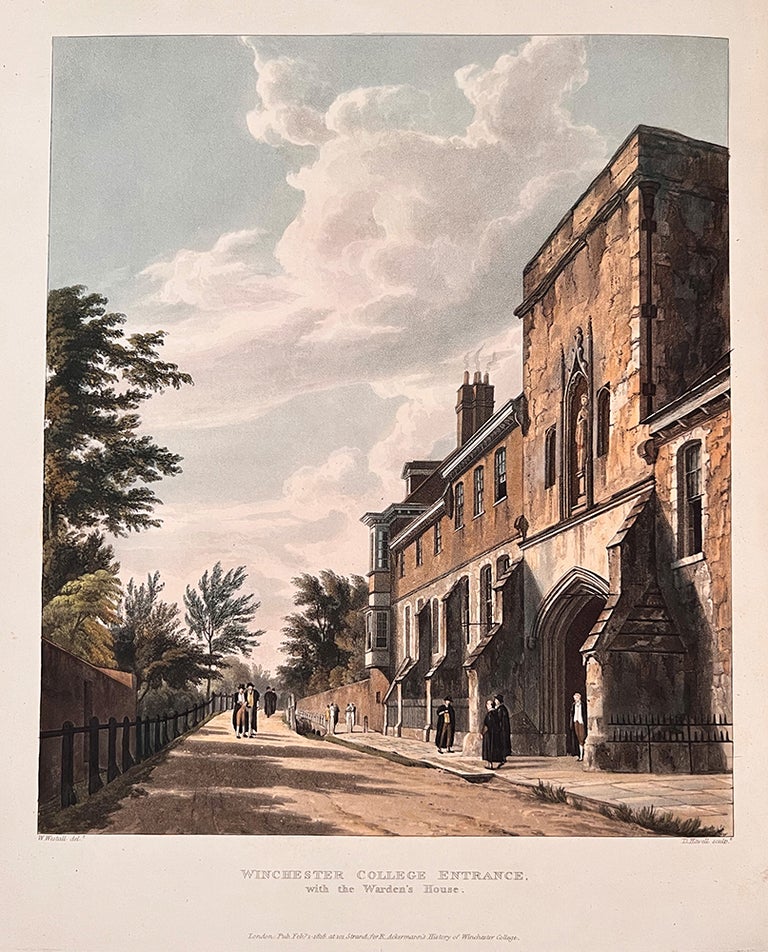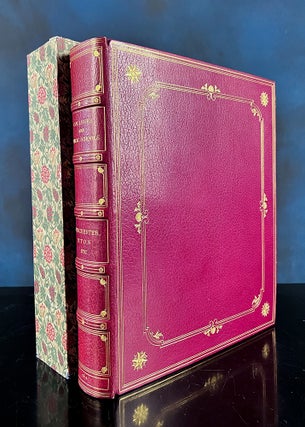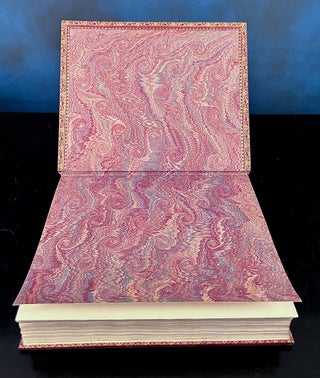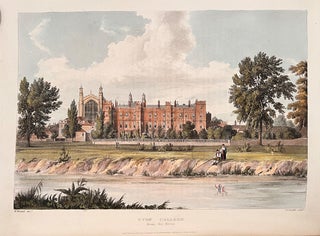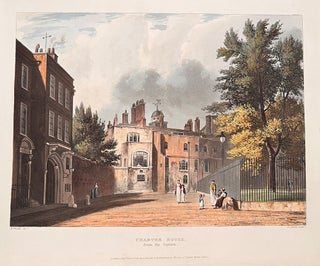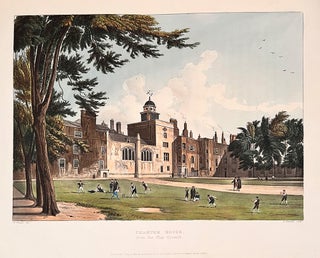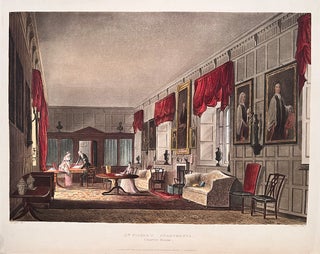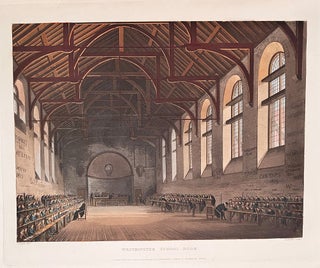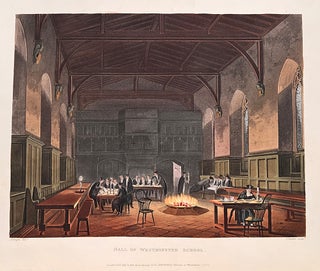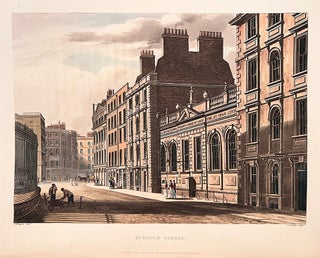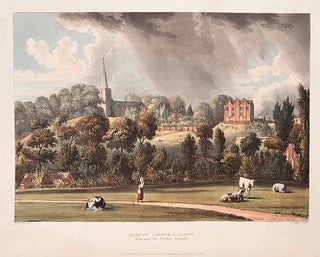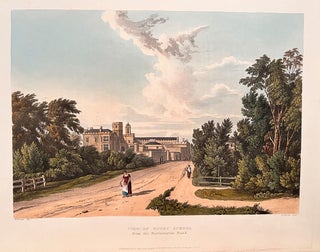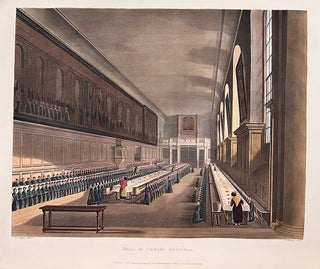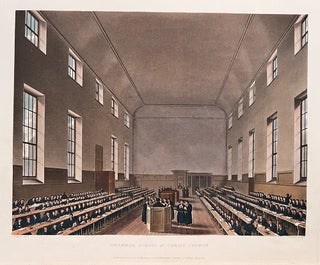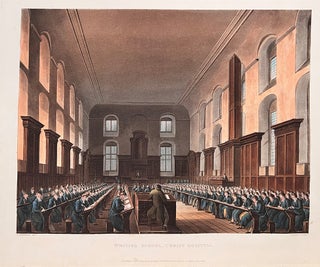History of the Colleges of Winchester, Eton, and Westminster, The
London: Printed for and Published by R. Ackermann, 1816. Item #05471
"Highest Praise" For Ackermann’s Colleges
"Equals, If Not Surpasses, That of Oxford and Cambridge"
[ACKERMANN, Rudolph, publisher]. The History of the Colleges of Winchester, Eton, and Westminster; with the Charter-House, the Schools of St. Paul’s, Merchant Taylors, Harrow, and Rugby, and the Free-School of Christ’s Hospital. London: Printed for and Published by R. Ackermann, 1816.
First edition, early issue. Large quarto (13 3/8 x 11 1/8 inches; 340 x 282 mm.). vi, [1, “Arrangement of Plates”], [1, blank], 56; 72; 27, [1, blank]; 32; 34; 22; 40; 34; 43, [1, blank] pp. With forty-eight hand-colored plates (forty-five aquatint and three engraved), including four costume plates and forty-four views by Havell, Stadler, Bluck, and others, after Westall, Mackenzie, Pugin, and others. All plates with tissue guards. Text watermarked 1816, plates watermarked 1812 and 1816.
Abbey's second state of Plate 6 (“Winchester College, from the Meadow”), dated “Jany. 1, 1816”; Abbey's second state of Plate 23 (“Westminster School Room”), with hats added to the masters; Abbey's second state of Plate 26 (”Charter House, from the Play Ground”), depicting thirteen boys and masters playing cricket (instead of washerwomen).
Handsomely bound ca. 1940 by Birdsall of Northampton & London (stamp-signed in gilt on lower front turn-in). Full red morocco, covers decoratively paneled and tooled in gilt. Spine with five raised bands decoratively ruled and lettered in gilt in compartments, decorative gilt board edges and turn-ins, cockerel endpapers, top edge gilt. Housed in a later leather-edged slipcase.
A wonderful example - the plates with early watermarks, all clean and fresh with superb hand coloring.
With the pencil marks of the late, great bookseller Charles W. Traylen of Guildford on the verso of the front free endpaper date "30. 11. 63"
“[Ackermann’s History of the University of Oxford (1813) and History of the University of Cambridge (1814)] were fittingly followed by a History of the Colleges…Of this also a thousand copies were issued in monthly parts, the first appearing on January 1, 1816…The text, with the exception of the parts dealing with Winchester, Eton, and Harrow (the work of W.H. Pyne), were entirely written by Combe, and the same artists were employed in its decoration, the highest praise for which is that it equals, if not surpasses, that of Oxford and Cambridge. The original drawings for the forty-eight coloured plates were distributed among Westall, who executed fifteen, and Pugin and Mackenzie, who did fourteen each, while one is by J. Gendall, who besides illustrating Ackermann’s publications was employed for some years in managing his business, particularly in developing the new art of lithography. The actual engraving was done by Havell and Stadler, with a few plates by Bluck and Bennett, and four line engravings of costume by Agar after Uwins. Here again it may be noticed that many of the aquatints are printed in two colours before being finished by hand” (Martin Hardie).
The roots of Birdsall of Northampton "stretch back to the early eighteenth century but it was in 1792 that John Lacy's Northampton bindery was acquired by William Birdsall, continuing in his family until 1961...In Birdsall's heyday, Gerring (Notes on Bookbinding, 1899) reported a staff of 250 engaged in making ladies handbags, fancy boxes, and stationary; as well as all types of bookbinding. The firm seemed always ready to experiment and careful records and samples were kept by Richard Birdsall, great-great-nephew of the founder, until he died in 1909...The firm's collection of over 3,000 finishing tools passed to the University of Toronto" (Maggs, Bookbinding in the British Isles II, #262, and #321).
"Birdsall's is notable for the high quality of their leathers and finishings, as well as for the inventive style of their 'inlaid pictorial bindings'" (Chevalier Collection, Christie's November 9, 1990).
Abbey, Scenery, 440; Adams, London Illustrated, 116; Martin Hardie, pp. 106-107; Prideaux, pp. 126 and 332;
Tooley 3.
Price: $5,500.00

 I have been in the rare and antiquarian book business for over forty years; my family has been in the rare books business since 1876. Rare books are in my blood.
I have been in the rare and antiquarian book business for over forty years; my family has been in the rare books business since 1876. Rare books are in my blood.
